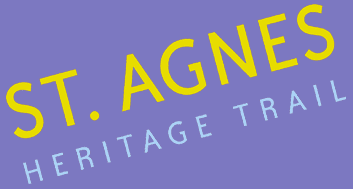
Walk 1 - St.Agnes Village Trail
To the right of the Church tower just before the main entrance, stands an ancient Celtic cross thought to date from the 7th century. A thirteenth century chapel on this site gave rise to a church built in 1484 when the population had grown much faster than that of the settlements of the mother church of Perranzabuloe.
In the 1830s, Tom Chynoweth explains: "As for that there story they goat 'bout us, that we dunged our tower to make un grow, 'twas nawthin moore than this: 'I'll have ivy graw oal roun' the tower' says the passon.' 'And so you shall my deer,' says the churchwarden. And when the passon was gone, he beginned to put some in: a Trura man looked in and I I H Inside the church Miners at West Kitty mine. c.1855 c.1910 c.1910 seed un, and thoft he was dungin' the tower, to make un graw, and went hum and said so: and from that time they do ax how the tower do git on. And that's how it was, and nawthin' moore. And the ivy never grawd, nor the tower, of coose; and the moore the pity, for he's oncommon short."
In 1848 the old church was largely demolished and rebuilt in its current form, the tower remained from the church of 1484, so this is certainly one of the oldest structures in Churchtown, built at a time when use of the Cornish language would have been commonplace. Inside the church one of the survivals from the old church is an interesting Elizabethan carved wooden figure of a hungry man which supports the alms box for the poor.
Back tracking slightly, next to Lee and Co. is an example of an Ope (usually pronounced "op") or op-way, a path linking Churchtown with the "back of town" (alias West Kitty, after West Kitty tin mine which worked from 1863 until 1915, employing 378 people at its peak in 1905). Take a stroll up the op and feel the antiquity of the lime-washed cottages. It is still possible to discern the one up, one down stone and "cob" (a form of compacted earth) cottages incorporated into the modern buildings. Bear right along the road at the rear of the St. Agnes Hotel.
 The St. Agnes Hotel car park was once a field where the hotel cow was kept. Part of this small "field" was the hotel garden, one of many vegetable plots around the village.
The St. Agnes Hotel car park was once a field where the hotel cow was kept. Part of this small "field" was the hotel garden, one of many vegetable plots around the village.
As Mr. Harper recalls, "Lots of miners had small holdings. My father kept fowls out at the croft where Dobles are." In this way, families made ends meet. Continue to the junction, turn right back towards the church, then left, past St. Agnes Bakery down Town Hill.
Look left for the nine stepped cottages of Stippy Stappy formerly known as Cottage Row J. Built around 1841 and owned by the Hitchins family who managed St. Agnes Harbour, many of the tenants were sea captains or seamen. When the Hitchins estate was auctioned off in 1929 the average price fetched for each cottage was £60.
 Further down Town Hill on the right is a boarded-up granite entrance to some steps K. Stand back! That group of
running men you can hear just about to burst out of the gate are Coastguards racing for the Cove, there is a ship in
trouble and the rocket apparatus needs their help L.
Further down Town Hill on the right is a boarded-up granite entrance to some steps K. Stand back! That group of
running men you can hear just about to burst out of the gate are Coastguards racing for the Cove, there is a ship in
trouble and the rocket apparatus needs their help L.
 Walk 1 - St.Agnes Village Trail
Walk 1 - St.Agnes Village Trail Walk 2 - St Agnes Beacon
Walk 2 - St Agnes Beacon Walk 3 - Porthtowan, Banns Vale, Mount Hawke and Chapel Porth
Walk 3 - Porthtowan, Banns Vale, Mount Hawke and Chapel Porth Walk 4 - Wheal Rose, The Poldice Plateway and Mawla
Walk 4 - Wheal Rose, The Poldice Plateway and Mawla Walk 5 - Mount Hawke
Walk 5 - Mount Hawke Walk 6 - Mithian
Walk 6 - Mithian Walk 7 - Wheal Coates, Chapel Porth, Wheal Lawrence Valley and Goonvrea
Walk 7 - Wheal Coates, Chapel Porth, Wheal Lawrence Valley and Goonvrea Walk 8 - Water Lane, Wheal Butson and Jericho Valley
Walk 8 - Water Lane, Wheal Butson and Jericho Valley Walk 9 - Jericho Valley and Cross Coombe
Walk 9 - Jericho Valley and Cross Coombe Walk 10 - Blackwater
Walk 10 - Blackwater
